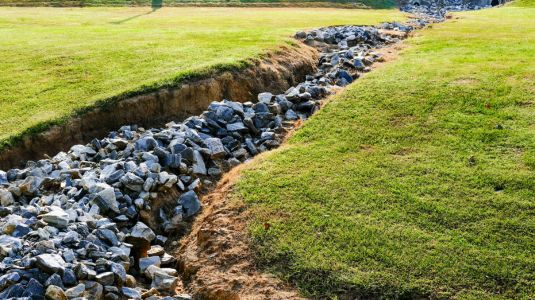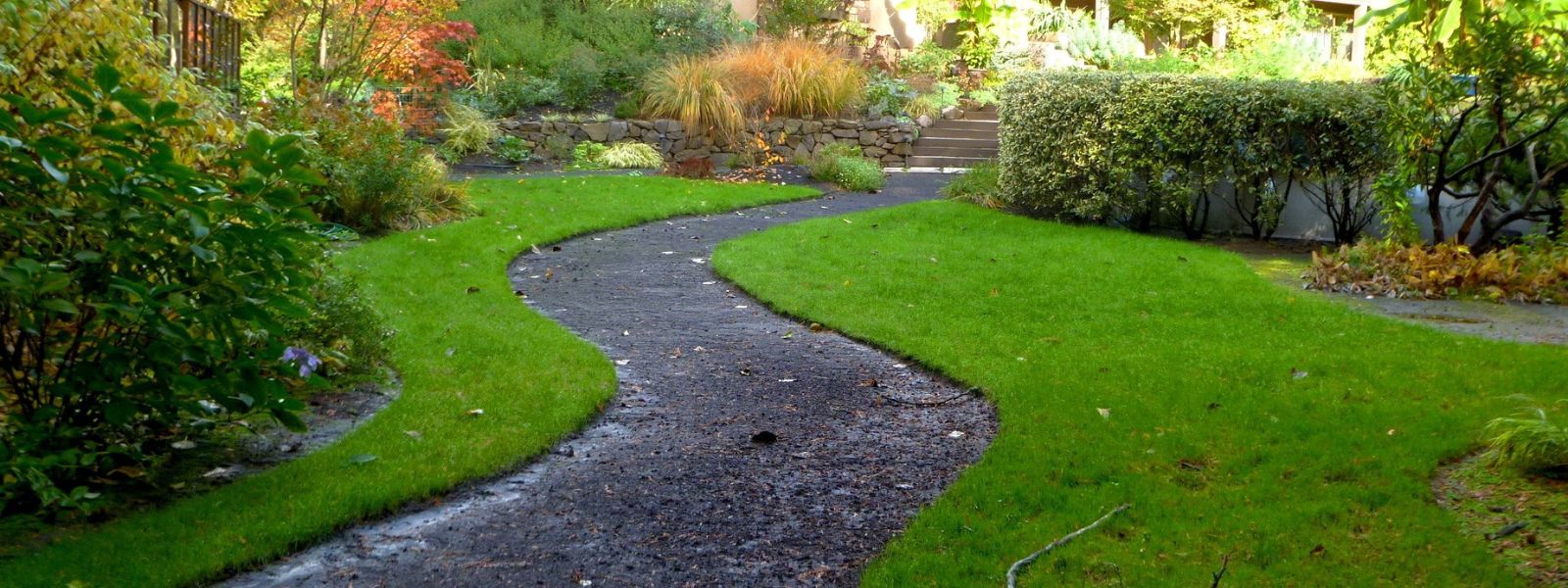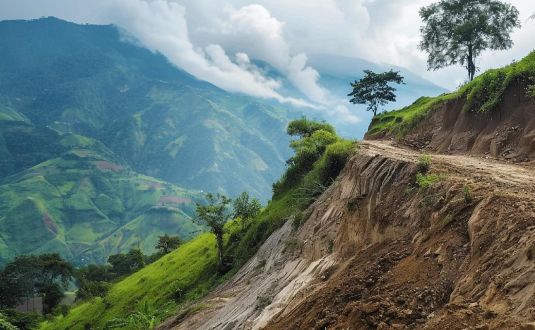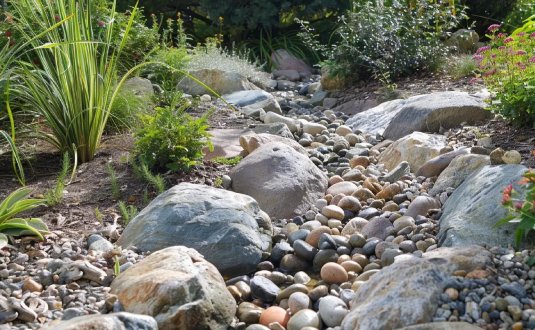Providing Best Services in Huntsville, AL
Providing Best Landscaping Services in Huntsville, AL



.webp)
How to Improve Yard Drainage Without Tearing Up Your Lawn
You can fix yard drainage problems without removing your grass. Simple methods like soil aeration, organic matter addition, and downspout adjustments solve most water issues while keeping lawns healthy. Standing water kills grass and creates mosquito breeding grounds. Poor drainage affects millions of yards nationwide, creating frustration for homeowners who want beautiful outdoor spaces.
How to Improve Yard Drainage Without Tearing Up Your Lawn
Water pooling damages lawn health, attracts pests, and threatens home foundations.
What Causes Poor Yard Drainage?
Soil compaction creates most drainage problems in residential yards. Heavy foot traffic, construction equipment, and clay soil naturally compress earth particles together. Research from the University of Minnesota Extension shows soil compaction can reduce water infiltration by up to 60 percent in affected areas.
Water pools form when soil cannot absorb rainfall fast enough during storm events. Clay particles pack tightly together and create impermeable layers that block natural water movement through earth profiles. Dense soil prevents oxygen from reaching grass roots, leading to suffocation and plant death.
Construction activities contribute significantly to compaction problems. Heavy machinery compresses soil layers up to 300 millimeters deep during building projects.
Natural clay content varies by geographic region. Areas with heavy clay soils experience more severe drainage challenges than sandy regions.
Sand mixed incorrectly with clay makes concrete-like conditions worse than original soil. Adding sand alone to clay creates impermeable barriers rather than drainage solutions.
Poor grading compounds drainage issues across residential properties. Slopes that direct water toward houses instead of away create foundation risks.
How Do You Test Soil Drainage Speed?
A simple hole test reveals your soil's drainage rate in under 4 hours of testing time. Dig a hole 12 inches deep and 12 inches wide in the problem area using a standard spade. Fill the hole completely with water and let it drain naturally without assistance.
Fill the hole again with water once initial drainage completes. Time the second drainage event using a stopwatch or smartphone timer. Record the total time required for complete water disappearance from the test hole.
Good drainage means water disappears in 1-3 hours during optimal conditions. Water taking longer than 4 hours indicates serious drainage problems that need immediate correction. Test results help determine appropriate improvement strategies for specific soil conditions.
Conduct multiple tests across different yard areas to identify drainage patterns. Spring and fall provide ideal conditions for drainage testing.
Does Lawn Aeration Improve Drainage?

Core aeration creates holes that allow water to penetrate compacted soil layers effectively. This mechanical process removes soil plugs ½ to ¾ inches wide and 3-4 inches deep throughout affected lawn areas. The resulting holes provide direct pathways for water, oxygen, and nutrients to reach struggling grass roots.
Professional-grade aerators create approximately 25-40 holes per square foot of treated lawn surface. Rental equipment handles larger properties more efficiently than manual tools.
Aeration timing affects results significantly. Cool-season grasses benefit from fall aeration when root growth peaks. Warm-season varieties respond better to late spring aeration.
Core aeration works best on moist soil that yields easily to mechanical pressure. Water your lawn lightly 24 hours before planned aeration. Make two passes in different directions for maximum coverage.
Clay soils need annual aeration to maintain drainage improvements. Sandy soils need aeration every 2-3 years depending on traffic levels.
What Organic Materials Improve Soil Drainage?
Compost and aged manure break up compacted soil and create better water flow patterns naturally. Organic matter binds soil particles into stable aggregates with beneficial spaces between them. These spaces allow water movement while preventing harmful erosion during heavy rainfall events.
High-quality compost provides the most versatile organic amendment for drainage improvement projects. Aged cow manure mixed with sand creates effective amendments for heavy clay soils.
Apply organic materials through topdressing techniques. Spread ¼ to ½ inch layer evenly across affected lawn areas using a rake.
Organic matter increases the soil's cation exchange capacity significantly. This improvement enhances the soil's ability to hold beneficial nutrients while releasing excess water appropriately.
Professional soil testing reveals specific organic matter deficiencies before amendment selection. Most residential soils contain only 1-2 percent organic matter when optimal levels reach 3-5 percent.
How Do Gutters Affect Yard Drainage?
Clogged gutters and short downspouts dump excess water directly onto lawn surfaces below. This concentrated water flow overwhelms natural soil absorption capacity and creates soggy areas near house foundations. Roof drainage systems handle thousands of gallons during storm events.
A typical 1,000 square foot roof section generates approximately 600 gallons of runoff during a one-inch rainfall event. This volume concentrated in small areas exceeds most soil absorption rates.
Downspout extensions prevent concentrated water discharge that creates muddy yard conditions near building foundations. Extensions move water 6-10 feet away from structures.
Clean leaves and debris from all gutters twice yearly for proper function. Install splash blocks under downspouts to spread concentrated water over wider surface areas.
Can You Fix Drainage Without Regrading the Entire Yard?
Small grading adjustments solve most surface water problems without major construction projects or equipment. Add quality topsoil to low spots where water collects after rainfall events. Create gentle slopes of 2-3 inches per 10 feet away from house foundations for proper drainage flow.
Surface grading modifications cost significantly less than comprehensive drainage solutions requiring excavation work. Small grading projects require 2-5 cubic yards for typical problem areas.
Build small earthen berms to redirect water flow toward street drains. Fill depressions with quality topsoil and reseed with appropriate grass varieties.
Hand tools handle most small grading projects effectively without heavy equipment rental. Professional grading costs $1,500-5,000 for comprehensive residential projects.
What Plants Handle Wet Soil Conditions Naturally?
Water-loving plants transform persistent problem areas into attractive landscape features that manage excess moisture naturally. Native species adapted to wet conditions thrive in areas where regular turfgrass struggles consistently. These plants provide practical solutions while enhancing property aesthetics significantly.
Trees for wet areas include river birch (Betula nigra) and red maple (Acer rubrum) varieties. These species tolerate seasonal flooding while providing shade year-round.
Shrubs that tolerate moisture include buttonbush (Cephalanthus occidentalis) and summer sweet (Clethra alnifolia) cultivars. These flowering shrubs provide wildlife habitat while managing wet soil conditions.
Rain gardens using these plants manage excess water while adding visual interest to residential landscapes. Professional landscaping installation services handle complex plant establishment projects effectively.
When Should Homeowners Call Drainage Professionals?
Professional help becomes necessary for foundation threats and severe grading issues that exceed DIY capabilities. Water pooling against house foundations can cause structural damage costing thousands in repair expenses. Foundation problems require immediate attention to prevent escalating damage.
Standing water near foundations lasting more than 24 hours after rainfall indicates serious drainage problems requiring professional intervention. Foundation water damage repair costs average $3,500-8,000 depending on severity.
Large-scale yard erosion problems require professional assessment to prevent property damage. Severe erosion can undermine structures and create safety hazards.
Persistent standing water issues that resist multiple DIY improvement attempts indicate underlying problems requiring professional diagnosis.
How Much Do DIY Drainage Improvements Cost?
Most homeowners spend under $500 fixing drainage problems using these proven methods. Core aerator rentals cost $40-60 for weekend use. Quality compost delivery costs $30-50 per cubic yard.
Hand aeration tools cost $50-150 for manual soil plug removal in small areas. Professional soil testing costs $15-50 per sample and provides valuable information for amendment selection.
This cost comparison favors DIY approaches significantly over professional drainage installations that cost $2,000-8,000 for major projects.
What Maintenance Keeps Drainage Improvements Working Long-Term?
Monthly gutter cleaning and annual aeration maintain proper water flow patterns. Check problem areas 24 hours after heavy rainfall to verify improvement effectiveness.
Add fresh compost topdressing each fall before winter dormancy periods. Avoid walking on wet grass to prevent new compaction problems.
Professional hardscaping solutions provide permanent traffic management in heavily used areas. Walkways and patios reduce soil compaction while improving property functionality.
Does Thatch Removal Help Drainage Significantly?
Thick thatch layers block water from reaching soil and grass root systems effectively. Thatch consists of dead grass stems and roots that accumulate between living grass and soil surfaces. Layers exceeding ½ inch thickness create waterproof barriers.
Power rakes remove excess thatch mechanically using rotating tines. Set tines ¼ to ½ inch deep to remove thatch without damaging healthy grass roots.
Combine dethatching with aeration and topdressing for maximum drainage improvement results. Thatch removal improves fertilizer and water penetration rates by 25-40 percent in affected areas.
What Mistakes Worsen Drainage Problems Significantly?
Adding sand alone to clay soil creates concrete-like conditions that block water movement completely. Sand particles fill spaces between clay particles instead of creating beneficial drainage channels.
Working wet soil increases compaction problems while destroying soil structure. Wait for proper moisture conditions before starting any soil improvement activities.
Over-aerating more than twice yearly damages grass root systems while providing no additional drainage benefits. Annual aeration provides optimal benefits for most residential lawns.
How long do drainage improvements take to work effectively?

Aeration and gutter fixes show immediate results after the next significant rainfall event. Organic matter amendments take 3-6 months to integrate fully with existing soil.
Topdressing with compost requires 2-3 growing seasons to show maximum long-term benefits. Plant establishment for wet-area gardens requires 1-2 full growing seasons for complete effectiveness.
Monitor problem areas for one complete year after improvements to verify long-term effectiveness. Soil structure improvements become permanent after 2-3 years of proper maintenance.
Frequently Asked Questions
How often should I aerate my lawn for drainage?
Clay soils need annual aeration to maintain proper drainage and prevent recompaction from normal use. Sandy soils require aeration every 2-3 years depending on foot traffic levels. Heavily used areas may need twice-yearly treatment regardless of soil type.
What's the best time of year to improve drainage?
Spring and fall provide optimal conditions for most drainage improvement projects. Soil moisture levels remain consistent during these seasons without extreme temperature stress. Avoid summer improvements during peak heat periods when grass experiences natural stress.
Can I use sand from my local beach or sandbox?
Never use beach sand or construction sand for drainage improvements. These materials contain salt, fine particles, or contaminants that damage soil structure. Purchase washed, coarse sand specifically labeled for drainage or construction use from reputable suppliers.
How deep should drainage improvements go?
Most residential drainage improvements work effectively at 6-12 inch depths below surface level. Deeper improvements require professional assessment to avoid utility lines and structural foundations. Hand tools typically reach optimal depths for homeowner projects safely.
Will drainage improvements harm my existing grass?
Properly timed drainage improvements enhance grass health rather than causing damage to established lawns. Avoid treatments during stress periods like drought or extreme heat when grass cannot recover quickly. Spring and fall timing minimizes grass stress while maximizing improvement benefits.
How much water should drain from my test hole hourly?
Good drainage removes 2-6 inches of water per hour from properly sized test holes during optimal conditions. Slower rates indicate compaction problems requiring mechanical or organic improvement treatments. Faster drainage may indicate sandy soils needing water retention improvements.
• Professional drainage assessment costs $200-500 for comprehensive property evaluation • DIY drainage improvements typically cost 60-80 percent less than professional installation
Final Thoughts
Gentle drainage methods protect existing lawns while solving water problems effectively across diverse property conditions. Start with simple aeration and organic matter additions before considering expensive construction projects that disrupt established landscapes. Address obvious issues like clogged gutters and surface grading problems first for maximum cost effectiveness.
Most drainage challenges respond well to these proven approaches within one complete growing season. Combine multiple methods for best results in challenging soil conditions or severe problem areas. Patient homeowners achieve superior long-term results compared to those seeking instant solutions.
Professional landscape design services provide expert assessment when DIY methods prove insufficient for severe drainage challenges affecting property foundations or extensive areas. Proper professional consultation prevents costly mistakes while ensuring long-term success for complex projects requiring specialized expertise and equipment.
Stay Connected and Inspired
Get the latest landscaping tips, seasonal care guides, and exclusive offers delivered straight to your inbox. Don’t miss out on expert advice and ideas to transform your outdoor spaces.
Sign Up for Our Newsletter Today!


Your Next Idea Awaits
Stay inspired with our latest landscaping tips and trends.
.webp)
.webp)

.webp)
.webp)
.webp)
.webp)
.webp)

.webp)








.webp)
.webp)





